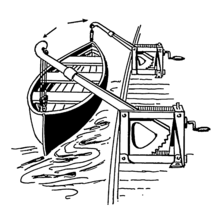
A davit is any of various cranelike devices used on a ship for supporting, raising, and lowering boats, anchors, etc.
Davit systems are most often used to lower an emergency lifeboat to the embarkation level to be boarded. Davits can also be used as man-overboard safety devices to retrieve personnel from the water.
The lifeboat davit has falls (now made of wire, historically of manila rope) that are used to lower the lifeboat into the water. Davits can also refer to single mechanical arms with a winch for lowering and raising spare parts onto a vessel and for lowering any other equipment from the deck of a vessel or a pontoon to the water. The maintaining and operation of davits is all under jurisdiction of International Maritime Organization. The regulations are enforced by the country's own Coast Guard.
The development of the davit from its original "goose neck form" to the current devices advanced greatly when A.P. Schat patented a number of systems in 1926 that allowed the lifeboat to glide over obstructions on a ship's hull, known as the "Schat Skate". This was followed by a self-braking winch system that allowed the lifeboat to be lowered evenly. The standard became so common that shipyard specifications call for Schat-type davits which are available from various sources. Similar systems developed by Schat companies are used on offshore oil or gas rigs, being placed around the structure.